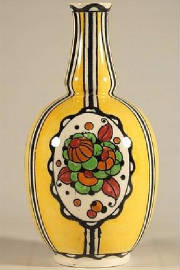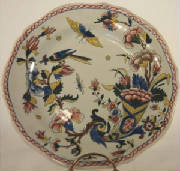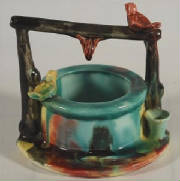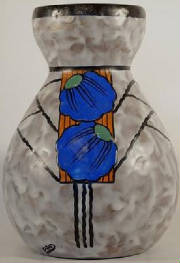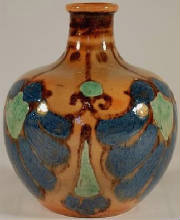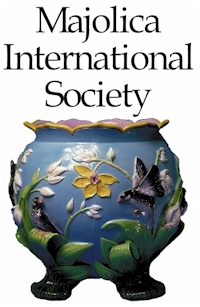History of "Pots Jacqueline" & "Jacquot"
Though
the English Toby jug may be better known, it owes its basic form to a faience jug that became popular in the Netherlands,
Flanders, and the north of France more than 200 years before the first Toby appeared on English shores. While the official
history of these Delft pitchers is lost to time, the legend of their origin lives on. Their creation is credited to
the colorful and romantic Jacqueline de Baviére (b. 1401; d. 1436), the countess of Hainaut, Zeeland, and Holland.
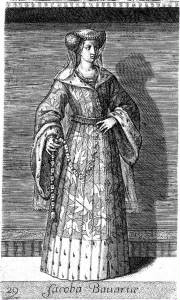 Jacqueline was the only child and heir of William de Baviére, Count of Hainaut, Zeeland, and Holland. As a five-year-old
child, she was betrothed to eight-year-old John of Valois, the fourth son of Charles VI, King of France and was married to
him nine years later in 1415. Four months after they were married, Jacqueline found herself married to the heir-apparent
to the throne of France when John's elder brother, Louis, died, making her husband, John, the Dauphin of France.
However, any dreams she might have relished of the French throne were destined to be short-lived: John died a scant eighteen
months later (April, 1417), ostensibly of an abscess in his neck, though there were rumors galore of poison. Less than
two months after her husband's death, Jacqueline's father died, leaving Jacqueline a fatherless widow and sovereign
of three strategic and powerful counties at the tender age of sixteen.
Jacqueline was the only child and heir of William de Baviére, Count of Hainaut, Zeeland, and Holland. As a five-year-old
child, she was betrothed to eight-year-old John of Valois, the fourth son of Charles VI, King of France and was married to
him nine years later in 1415. Four months after they were married, Jacqueline found herself married to the heir-apparent
to the throne of France when John's elder brother, Louis, died, making her husband, John, the Dauphin of France.
However, any dreams she might have relished of the French throne were destined to be short-lived: John died a scant eighteen
months later (April, 1417), ostensibly of an abscess in his neck, though there were rumors galore of poison. Less than
two months after her husband's death, Jacqueline's father died, leaving Jacqueline a fatherless widow and sovereign
of three strategic and powerful counties at the tender age of sixteen.
Her uncles, John the Pitiless (Duke of Bavaria)
and John the Fearless (Duke of Burgundy), wasted no time-no sooner was her father put in the ground, and the two Johns were
grappling with each other for control of their young niece, and thereby, her inheritance. Of the two, John the Pitiless
was in a weaker position due to his overwhelming unpopularity with his subjects, and he was deeply indebted to John the Fearless
for rescuing him from his rebelling subjects just ten years before. John the Fearless won the contest for guardianship
of Jacqueline. Against her wishes, he immediately arranged a marriage between Jacqueline and her fifteen-year-old first
cousin, John IV, Duke of Brabant (I know, I know...another John!) and they were married in April 1418. To bring about
this marriage, John the Fearless pressured Pope Martin V for a papal dispensation, without which the marriage would have been
illegal since Jacqueline and John IV were first cousins. Jacqueline was less than impressed with her new husband; contemptuous
is probably the best description of her opinion: she found him immature, spoiled and weak.
While all this was
going on, Jacqueline's troublesome uncle, John the Pitiless, 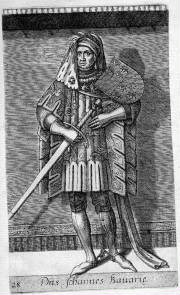 had NOT retired quietly to his corner; he was busy devising new schemes to wrest control of Jacqueline's inheritance.
He allied himself with Sigisbert of Germany against his niece and persuaded Sigisbert to appeal to Pope Martin V to rescind
the dispensation for the marriage. The Pope wasn't about to snub imperial Germany, so he duly rescinded the dispensation,
but it was too late-Jacqueline and John IV were already married. John the Pitiless wasn't finished with his machinations
against the young Jacqueline, he immediately began a tour of Jacqueline's counties of Hainaut, Zeeland, and Holland, claiming
them for himself and fueling a civil war between factions that supported him and the supporters of Jacqueline. She held
out for a little while, but eventually, John the Pitiless gained the upper hand. Phillip, the son of Jacqueline's
guardian, John the Fearless, brokered a truce in 1419 between Jacqueline and John the Pitiless, giving John the Pitiless control
of much of Jacqueline's territories. When John the Pitiless convinced Jacqueline's ineffectual husband, John
of Brabant, to mortgage the counties of Holland, Zeeland, and Friesland, to him for twelve years without Jacqueline's
consent, Jacqueline had had enough of her contemptible husband: This was the last straw for Jacqueline; she left her husband
and fled to Hainaut and then on to England, seeking refuge in the court of Henry V in late 1420.
had NOT retired quietly to his corner; he was busy devising new schemes to wrest control of Jacqueline's inheritance.
He allied himself with Sigisbert of Germany against his niece and persuaded Sigisbert to appeal to Pope Martin V to rescind
the dispensation for the marriage. The Pope wasn't about to snub imperial Germany, so he duly rescinded the dispensation,
but it was too late-Jacqueline and John IV were already married. John the Pitiless wasn't finished with his machinations
against the young Jacqueline, he immediately began a tour of Jacqueline's counties of Hainaut, Zeeland, and Holland, claiming
them for himself and fueling a civil war between factions that supported him and the supporters of Jacqueline. She held
out for a little while, but eventually, John the Pitiless gained the upper hand. Phillip, the son of Jacqueline's
guardian, John the Fearless, brokered a truce in 1419 between Jacqueline and John the Pitiless, giving John the Pitiless control
of much of Jacqueline's territories. When John the Pitiless convinced Jacqueline's ineffectual husband, John
of Brabant, to mortgage the counties of Holland, Zeeland, and Friesland, to him for twelve years without Jacqueline's
consent, Jacqueline had had enough of her contemptible husband: This was the last straw for Jacqueline; she left her husband
and fled to Hainaut and then on to England, seeking refuge in the court of Henry V in late 1420.
In England,
Jacqueline declared that her marriage to John IV, Duke of Brabant, had never been legal and she was free to marry...and apparently,
she had someone in mind-namely, Humphrey, Duke of Gloucester, brother to the King. This development outraged all the
Johns involved: both of her uncles, John the Pitiless and John the Fearless, as well as her abandoned husband, John IV of
Brabant. Philip, son of John the Fearless, was deeply chagrined to see a new and quite powerful player on the field
in the person of Humphrey of Gloucester. The last thing any of them wanted to see was the might of England brought into
the games they were playing. After much wrangling back and forth over the legality of the proposed marriage, Jacqueline
and Humphrey were married in 1422 without Pope Martin's papal blessing, though the rival Avignon pope, Benedict XIII,
was happy to do what Martin would not, and approved the marriage. The legality arguments continued even after the wedding
and Jacqueline and Humphrey decided to let war determine the legality of their marriage. In late 1424, they led an army
across the English channel and reached Hainaut, where Jacqueline and Humphrey were gladly received by the people as Countess
and Count of Hainaut.
Phillip of Burgundy had no intention of letting Jacqueline and Humphrey regain control
of her territories, and he, with his troops, mounted a contest against the Englishman and Jacqueline. In the skirmish,
Jacqueline fell into Phillip's hands and he imprisoned her in the donjon of his castle at Ghent. 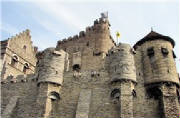 Humphrey gave up his efforts, abandoning Jacqueline to her fate, and returned to England, consoling himself with a new love
on his arm, Jacqueline's lady-in-waiting, Eleanor Cobham. For Jacqueline, perhaps the only bright spot during her
imprisonment was learning of the death of her hated nemesis, her uncle, John the Pitiless. He was poisoned, possibly
by, or at the behest of, her ex-husband John IV, Duke of Brabant, and died in January of 1425. Still, the death of John
the Pitiless did not leave Jacqueline any better off: Jacqueline never lacked for enemies or rivals, and his death, while
she languished in Phillip's donjon was of little benefit to her. Soon after the death of John the Pitiless, Jacqueline's
erstwhile husband, John IV of Brabant turned over control of Holland and Zeeland to Phillip by mortgaging those two counties
to him, just as he had done a few years earlier to John the Pitiless.
Humphrey gave up his efforts, abandoning Jacqueline to her fate, and returned to England, consoling himself with a new love
on his arm, Jacqueline's lady-in-waiting, Eleanor Cobham. For Jacqueline, perhaps the only bright spot during her
imprisonment was learning of the death of her hated nemesis, her uncle, John the Pitiless. He was poisoned, possibly
by, or at the behest of, her ex-husband John IV, Duke of Brabant, and died in January of 1425. Still, the death of John
the Pitiless did not leave Jacqueline any better off: Jacqueline never lacked for enemies or rivals, and his death, while
she languished in Phillip's donjon was of little benefit to her. Soon after the death of John the Pitiless, Jacqueline's
erstwhile husband, John IV of Brabant turned over control of Holland and Zeeland to Phillip by mortgaging those two counties
to him, just as he had done a few years earlier to John the Pitiless.
During her imprisonment, Jacqueline
is said to have amused herself by fashioning pottery pots or jugs in the form of a seated man or woman and tossing them down
from her cell to the townspeople below. (Could this have been some sort of communication between Jacqueline and her
numerous supporters?)  Certainly there must have been some sort of communication because in September 1425 two knights arrived at Phillip's castle
at Ghent and managed to slip a disguise to Jacqueline. She escaped the donjon in the guise of a man and made her way
to Gouda. This marked the beginning of a valiant three year effort by Jacqueline to regain control of her lands.
Jacqueline was no demure hot-house flower: as comfortable in full armor as she was in silk robes, she led her own troops into
battle, and, against the overwhelming might of Burgundy, fought courageously on the battlefield to preserve the lands which
were her heritage. She scored a fabulous victory against Phillip in October 1425, and her philandering husband, Humphrey,
was shamed into sending her aid in January 1426, but Phillip cut down the English forces mercilessly leaving Jacqueline on
her own in defending her lands. About this time, Pope Martin declared the John IV of Brabant was still legally Jacqueline's
husband, thus releasing Humphrey of any obligation to assist her further.
Certainly there must have been some sort of communication because in September 1425 two knights arrived at Phillip's castle
at Ghent and managed to slip a disguise to Jacqueline. She escaped the donjon in the guise of a man and made her way
to Gouda. This marked the beginning of a valiant three year effort by Jacqueline to regain control of her lands.
Jacqueline was no demure hot-house flower: as comfortable in full armor as she was in silk robes, she led her own troops into
battle, and, against the overwhelming might of Burgundy, fought courageously on the battlefield to preserve the lands which
were her heritage. She scored a fabulous victory against Phillip in October 1425, and her philandering husband, Humphrey,
was shamed into sending her aid in January 1426, but Phillip cut down the English forces mercilessly leaving Jacqueline on
her own in defending her lands. About this time, Pope Martin declared the John IV of Brabant was still legally Jacqueline's
husband, thus releasing Humphrey of any obligation to assist her further.
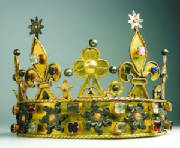 With no allies against the fearsome might of Burgundy, and against all reasonable odds, Jacqueline held out as long as she
could, but it was a doomed proposition from the start. In 1428, she was forced to accept a treaty with Phillip in which
she was allowed to keep her title, but ceded actual control of the counties of Holland, Zeeland, and Hainaut to Phillip.
Even after this catastrophic blow, she didn't abandon her dream of driving the Burgundians from her lands. John
IV of Brabant had died in 1427, leaving Jacqueline widowed for a second time. In 1430, Phillip mortgaged Holland
and Zeeland to the Borselen family. Jacqueline secretly married the most powerful of the Borselen's, Frank von Borselen,
in 1432, and together with other deposed nobles, tried to foment a rebellion to overthrow the Burgundians. Phillip threw
her husband into jail and the plot unraveled. Jacqueline was forced to abdicate her countship in 1433, and Burgundy
was firmly established as a reigning power in Europe. Jacqueline's stormy life came to its end a scant three years
later when she succumbed to tuberculosis, but her name and heroics live on to this day in the memories preserved in the charming
little human-shaped faience pots and jugs called "Pots Jacquelines" and "Pots Jacquot", and the romantic
story of an imprisoned countess tossing them from her donjon cell to her loyal followers six hundred years ago.
With no allies against the fearsome might of Burgundy, and against all reasonable odds, Jacqueline held out as long as she
could, but it was a doomed proposition from the start. In 1428, she was forced to accept a treaty with Phillip in which
she was allowed to keep her title, but ceded actual control of the counties of Holland, Zeeland, and Hainaut to Phillip.
Even after this catastrophic blow, she didn't abandon her dream of driving the Burgundians from her lands. John
IV of Brabant had died in 1427, leaving Jacqueline widowed for a second time. In 1430, Phillip mortgaged Holland
and Zeeland to the Borselen family. Jacqueline secretly married the most powerful of the Borselen's, Frank von Borselen,
in 1432, and together with other deposed nobles, tried to foment a rebellion to overthrow the Burgundians. Phillip threw
her husband into jail and the plot unraveled. Jacqueline was forced to abdicate her countship in 1433, and Burgundy
was firmly established as a reigning power in Europe. Jacqueline's stormy life came to its end a scant three years
later when she succumbed to tuberculosis, but her name and heroics live on to this day in the memories preserved in the charming
little human-shaped faience pots and jugs called "Pots Jacquelines" and "Pots Jacquot", and the romantic
story of an imprisoned countess tossing them from her donjon cell to her loyal followers six hundred years ago.
Back to top of page
Back to Brief History of Character Pitchers
Back to Library
Back to Shantique Gallery Home
Bibliography
History of the People of the Netherlands; Petrus Johannes Blok, Oscar Albert
Bierstadt, Ruth Putnam; G.P. Putnam's Sons, New York & London, 1899
Holland from 1299 to 1581: The History
of the Lowlands, http://www.geerts.com/holland/holland-3.htm,L.C. Geerts, May 2007
Jacqueline, Countess of
Hainaut, Wikipedia, http://en.wikipedia.org/wiki/Jacqueline,_Countess_of_Hainaut
John, Dauphin of France, Wikipedia,
http://en.wikipedia.org/wiki/John,_Dauphin_of_France_(1398-1417)
La céramique: Des exemples de parcours au
sein du département "céramique" du Palais des Beaux-Arts de Lille, 10 Nov 2005, http://netia59a.ac-lille.fr/~siteia/ressources_peda/ecole_culture/docs/html/Ceramique.html,
Palais des Beaux-Arts de Lille
Valois Burgundy, Richard Vaughan, Archon Books, 1975

 Jacqueline was the only child and heir of William de Baviére, Count of Hainaut, Zeeland, and Holland. As a five-year-old
child, she was betrothed to eight-year-old John of Valois, the fourth son of Charles VI, King of France and was married to
him nine years later in 1415. Four months after they were married, Jacqueline found herself married to the heir-apparent
to the throne of France when John's elder brother, Louis, died, making her husband, John, the Dauphin of France.
However, any dreams she might have relished of the French throne were destined to be short-lived: John died a scant eighteen
months later (April, 1417), ostensibly of an abscess in his neck, though there were rumors galore of poison. Less than
two months after her husband's death, Jacqueline's father died, leaving Jacqueline a fatherless widow and sovereign
of three strategic and powerful counties at the tender age of sixteen.
Jacqueline was the only child and heir of William de Baviére, Count of Hainaut, Zeeland, and Holland. As a five-year-old
child, she was betrothed to eight-year-old John of Valois, the fourth son of Charles VI, King of France and was married to
him nine years later in 1415. Four months after they were married, Jacqueline found herself married to the heir-apparent
to the throne of France when John's elder brother, Louis, died, making her husband, John, the Dauphin of France.
However, any dreams she might have relished of the French throne were destined to be short-lived: John died a scant eighteen
months later (April, 1417), ostensibly of an abscess in his neck, though there were rumors galore of poison. Less than
two months after her husband's death, Jacqueline's father died, leaving Jacqueline a fatherless widow and sovereign
of three strategic and powerful counties at the tender age of sixteen. had NOT retired quietly to his corner; he was busy devising new schemes to wrest control of Jacqueline's inheritance.
He allied himself with Sigisbert of Germany against his niece and persuaded Sigisbert to appeal to Pope Martin V to rescind
the dispensation for the marriage. The Pope wasn't about to snub imperial Germany, so he duly rescinded the dispensation,
but it was too late-Jacqueline and John IV were already married. John the Pitiless wasn't finished with his machinations
against the young Jacqueline, he immediately began a tour of Jacqueline's counties of Hainaut, Zeeland, and Holland, claiming
them for himself and fueling a civil war between factions that supported him and the supporters of Jacqueline. She held
out for a little while, but eventually, John the Pitiless gained the upper hand. Phillip, the son of Jacqueline's
guardian, John the Fearless, brokered a truce in 1419 between Jacqueline and John the Pitiless, giving John the Pitiless control
of much of Jacqueline's territories. When John the Pitiless convinced Jacqueline's ineffectual husband, John
of Brabant, to mortgage the counties of Holland, Zeeland, and Friesland, to him for twelve years without Jacqueline's
consent, Jacqueline had had enough of her contemptible husband: This was the last straw for Jacqueline; she left her husband
and fled to Hainaut and then on to England, seeking refuge in the court of Henry V in late 1420.
had NOT retired quietly to his corner; he was busy devising new schemes to wrest control of Jacqueline's inheritance.
He allied himself with Sigisbert of Germany against his niece and persuaded Sigisbert to appeal to Pope Martin V to rescind
the dispensation for the marriage. The Pope wasn't about to snub imperial Germany, so he duly rescinded the dispensation,
but it was too late-Jacqueline and John IV were already married. John the Pitiless wasn't finished with his machinations
against the young Jacqueline, he immediately began a tour of Jacqueline's counties of Hainaut, Zeeland, and Holland, claiming
them for himself and fueling a civil war between factions that supported him and the supporters of Jacqueline. She held
out for a little while, but eventually, John the Pitiless gained the upper hand. Phillip, the son of Jacqueline's
guardian, John the Fearless, brokered a truce in 1419 between Jacqueline and John the Pitiless, giving John the Pitiless control
of much of Jacqueline's territories. When John the Pitiless convinced Jacqueline's ineffectual husband, John
of Brabant, to mortgage the counties of Holland, Zeeland, and Friesland, to him for twelve years without Jacqueline's
consent, Jacqueline had had enough of her contemptible husband: This was the last straw for Jacqueline; she left her husband
and fled to Hainaut and then on to England, seeking refuge in the court of Henry V in late 1420.  Humphrey gave up his efforts, abandoning Jacqueline to her fate, and returned to England, consoling himself with a new love
on his arm, Jacqueline's lady-in-waiting, Eleanor Cobham. For Jacqueline, perhaps the only bright spot during her
imprisonment was learning of the death of her hated nemesis, her uncle, John the Pitiless. He was poisoned, possibly
by, or at the behest of, her ex-husband John IV, Duke of Brabant, and died in January of 1425. Still, the death of John
the Pitiless did not leave Jacqueline any better off: Jacqueline never lacked for enemies or rivals, and his death, while
she languished in Phillip's donjon was of little benefit to her. Soon after the death of John the Pitiless, Jacqueline's
erstwhile husband, John IV of Brabant turned over control of Holland and Zeeland to Phillip by mortgaging those two counties
to him, just as he had done a few years earlier to John the Pitiless.
Humphrey gave up his efforts, abandoning Jacqueline to her fate, and returned to England, consoling himself with a new love
on his arm, Jacqueline's lady-in-waiting, Eleanor Cobham. For Jacqueline, perhaps the only bright spot during her
imprisonment was learning of the death of her hated nemesis, her uncle, John the Pitiless. He was poisoned, possibly
by, or at the behest of, her ex-husband John IV, Duke of Brabant, and died in January of 1425. Still, the death of John
the Pitiless did not leave Jacqueline any better off: Jacqueline never lacked for enemies or rivals, and his death, while
she languished in Phillip's donjon was of little benefit to her. Soon after the death of John the Pitiless, Jacqueline's
erstwhile husband, John IV of Brabant turned over control of Holland and Zeeland to Phillip by mortgaging those two counties
to him, just as he had done a few years earlier to John the Pitiless.  Certainly there must have been some sort of communication because in September 1425 two knights arrived at Phillip's castle
at Ghent and managed to slip a disguise to Jacqueline. She escaped the donjon in the guise of a man and made her way
to Gouda. This marked the beginning of a valiant three year effort by Jacqueline to regain control of her lands.
Jacqueline was no demure hot-house flower: as comfortable in full armor as she was in silk robes, she led her own troops into
battle, and, against the overwhelming might of Burgundy, fought courageously on the battlefield to preserve the lands which
were her heritage. She scored a fabulous victory against Phillip in October 1425, and her philandering husband, Humphrey,
was shamed into sending her aid in January 1426, but Phillip cut down the English forces mercilessly leaving Jacqueline on
her own in defending her lands. About this time, Pope Martin declared the John IV of Brabant was still legally Jacqueline's
husband, thus releasing Humphrey of any obligation to assist her further.
Certainly there must have been some sort of communication because in September 1425 two knights arrived at Phillip's castle
at Ghent and managed to slip a disguise to Jacqueline. She escaped the donjon in the guise of a man and made her way
to Gouda. This marked the beginning of a valiant three year effort by Jacqueline to regain control of her lands.
Jacqueline was no demure hot-house flower: as comfortable in full armor as she was in silk robes, she led her own troops into
battle, and, against the overwhelming might of Burgundy, fought courageously on the battlefield to preserve the lands which
were her heritage. She scored a fabulous victory against Phillip in October 1425, and her philandering husband, Humphrey,
was shamed into sending her aid in January 1426, but Phillip cut down the English forces mercilessly leaving Jacqueline on
her own in defending her lands. About this time, Pope Martin declared the John IV of Brabant was still legally Jacqueline's
husband, thus releasing Humphrey of any obligation to assist her further.  With no allies against the fearsome might of Burgundy, and against all reasonable odds, Jacqueline held out as long as she
could, but it was a doomed proposition from the start. In 1428, she was forced to accept a treaty with Phillip in which
she was allowed to keep her title, but ceded actual control of the counties of Holland, Zeeland, and Hainaut to Phillip.
Even after this catastrophic blow, she didn't abandon her dream of driving the Burgundians from her lands. John
IV of Brabant had died in 1427, leaving Jacqueline widowed for a second time. In 1430, Phillip mortgaged Holland
and Zeeland to the Borselen family. Jacqueline secretly married the most powerful of the Borselen's, Frank von Borselen,
in 1432, and together with other deposed nobles, tried to foment a rebellion to overthrow the Burgundians. Phillip threw
her husband into jail and the plot unraveled. Jacqueline was forced to abdicate her countship in 1433, and Burgundy
was firmly established as a reigning power in Europe. Jacqueline's stormy life came to its end a scant three years
later when she succumbed to tuberculosis, but her name and heroics live on to this day in the memories preserved in the charming
little human-shaped faience pots and jugs called "Pots Jacquelines" and "Pots Jacquot", and the romantic
story of an imprisoned countess tossing them from her donjon cell to her loyal followers six hundred years ago.
With no allies against the fearsome might of Burgundy, and against all reasonable odds, Jacqueline held out as long as she
could, but it was a doomed proposition from the start. In 1428, she was forced to accept a treaty with Phillip in which
she was allowed to keep her title, but ceded actual control of the counties of Holland, Zeeland, and Hainaut to Phillip.
Even after this catastrophic blow, she didn't abandon her dream of driving the Burgundians from her lands. John
IV of Brabant had died in 1427, leaving Jacqueline widowed for a second time. In 1430, Phillip mortgaged Holland
and Zeeland to the Borselen family. Jacqueline secretly married the most powerful of the Borselen's, Frank von Borselen,
in 1432, and together with other deposed nobles, tried to foment a rebellion to overthrow the Burgundians. Phillip threw
her husband into jail and the plot unraveled. Jacqueline was forced to abdicate her countship in 1433, and Burgundy
was firmly established as a reigning power in Europe. Jacqueline's stormy life came to its end a scant three years
later when she succumbed to tuberculosis, but her name and heroics live on to this day in the memories preserved in the charming
little human-shaped faience pots and jugs called "Pots Jacquelines" and "Pots Jacquot", and the romantic
story of an imprisoned countess tossing them from her donjon cell to her loyal followers six hundred years ago.
